It’s been seven years since my last interview with the director of the Hanoverian Verband, Werner Schade in 2007. In that time, so many dramatic changes have occurred in the world of Warmblood breeding, changes that neither of us could have predicted seven years ago. Who would have thought that the whole French National Stud system would disappear? That Flyinge, the jewel of Swedish breeding would disappear? That most of the great Oldenburg stallion stations would disappear? And that the numbers of mares being bred throughout Europe would have fallen so dramatically…
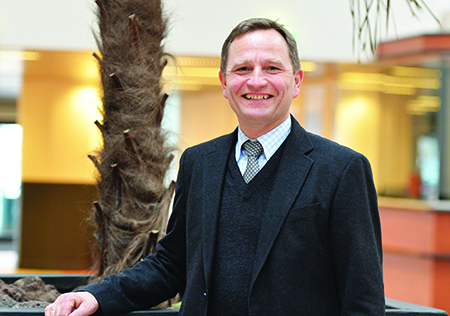
“I think the biggest changes have been structural,” said Werner, “The changes in the community of breeders. We see many breeders with a farming background have given up breeding in the last few years – with the change of generations, whole farms have disappeared. The number of mare coverings have gone down, so there are problems for all the breeding associations in Germany, we are losing members, losing revenue. Breeding horses is becoming more and more professional, and the quality of the horses in the market is still strong, but after the financial crisis and the economic problems, the market went down, and this pushed along the structural changes.”
“We also see that breeding becomes more and more international. The stallion owners are more and more involved in equestrian sport – and if the stallion owner is unable to combine breeding and sport, then it is very difficult for them to survive. The ones who do go well in the sport, then their stallions go well at stud. The internationalism has seen a much greater exchange between the European breeding associations, with the bloodlines flowing from one country to another, from one association to the other.”
If we look at the new emerging markets – for instance, the Arab and Asian markets, those buyers are not going to purchase foals, or three years olds, and raise and train them, they want horses that are already competing at the top…
“The Hanoverian Association started to work on the Asian market, especially the Chinese market, in 2012, entering into partnerships with training centres in China, to see what is happening there, and our experience is that it is an up-and-coming market. We think it will be a strong market, but it is disorganized, and there are not enough people with the knowledge of training and horse care, so that is a problem. That means if you want to be successful in this market, you have to deliver the whole package, not only the horse. Training is especially important, and we do that – we send trainers to China to train the horses we sell, or we sell the horses to China and keep them in Germany and train them there. Our early experiences have been good, it’s a very positive development.”
“Aside from Asia, for us the South American market is very interesting. That is one area we are looking at very carefully, they have had a horse culture, but now they are getting more interested in events like dressage or showjumping or eventing.”
“Our home market is still very important. Out of our auctions, we sell 50% to our home market in Germany, but it is still not enough. The number of competitors in equestrian sport in Germany shows a very good stability, and we expect our domestic market to continue to grow. With less horses in the future, because of the reduction in the number of coverings, the market in Europe could become more interesting because the numbers in competition are not so bad.”
You have managed to soften the blow by amalgamating with a number of smaller stud books, but the rumour that I keep hearing is that there is to be a merger of Holstein and Hanover, is that someone drinking too much schnapps?
“I think so, but I cannot say what will happen in the future. In my view the associations in Germany have to talk together. We have a good relationship with the other associations…”
Wouldn’t it be more logical just to have a German jumping horse studbook and a dressage horse book…
“I don’t think so. I think we have to keep some brands in Germany. My idea is not to create a ‘German Riding Horse’, we have to keep our brands because we have a high identification between the breeders and those brands and the regions, but I think in the back office, we have to find a way for the associations to work together to reduce the costs.”
“I think it is interesting to have different breeding programs and breeding philosophies. I am sure that the number of breeding associations in Germany will be reduced, but I expect it will be more an evolution, not part of a master plan.”
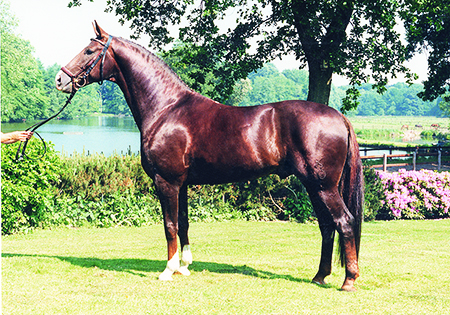
The legendary Donnerhall – a stallion producer
Looking at the bloodlines being used in Hanover now, it seems to be floating without a clear direction – once there was strong direction, Weltmeyer, but he has not bred on, and from the outside it looks as if the breeders are looking for the next lead…
“I think this is a logical development because of the use of artificial insemination, the semen is available everywhere, but still I think the anchor is the mare population, and in that mare population, Weltmeyer is very important, and we are very happy to have this bloodline.”
But it is curious, because Weltmeyer looked like the sort of stallion who would produce stallion sons…
“It didn’t happen, the sons didn’t come through like their father.”
Really only Donnerhall did…
“Donnerhall did, Rubinstein did not, but no doubt Donnerhall did. Some stallions are more mare producers, some are both, some are stallion producers, but I think a successful breeding program depends on the quality and the selection of the mares and mare families. I think there is an over-estimation of the importance of the stallions, and it is really the mares we should be looking at. You need a good stallion, that is no doubt, but if the average of the mare population is very high, the stallions are a little inter-changeable. This is why, especially in Hanover, we are in a good situation because we take care of the strong mare families, and they come through, every time.”
What stallions do you have hopes for?
“He is an older stallion, but we are very happy with De Niro. He is a world class producer, one of the best we have, and we are also happy with the sons, like Dancier and Desperados, and we expect good offspring from this line, very often in combination with Weltmeyer blood, also Wolkenstein blood.”
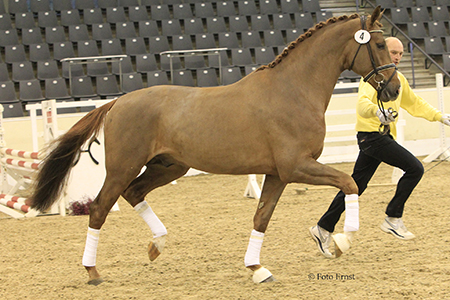
Burlington II – carrying on the B line
And the newly invigorated ‘B’ line?
“I am sure that we have some very good Belissimo sons in the breed and they are also going in a good way in the sport, this renaissance of the B line will be successful. Breitling is a very good example of how sometimes old-fashioned types or old-fashioned bloodlines, can produce modern horses. We just licensed a full brother of Nürnberger Burgpokal champion, Burlington (Breitling / Rohdiamant), an outstanding horse. I am sure that the B line has a good future.”
In jumping, we have had Stakkato, and now we are starting to see genuine world class Grand Prix jumpers by Stakkato, but you can’t just keep breeding to him…
“Stakkato is now also coming up on the dam line, because we have some very good Stakkato mares, and they make a good combination with stallions like Diarado or Chacco Blue or Acorado – this combination with Holsteiner bloodlines matched with Hanoverian mare families, is producing very good results. At the last licensing we were very happy with the quality of the jumping horses, it is a good and safe combination, Holsteiner bloodlines and Hanoverian mares, and we have seen that work now for a number of generations.”
“Also the sons of Stakkato, like Stolzenberg, are very good sires for the jumping breed.”
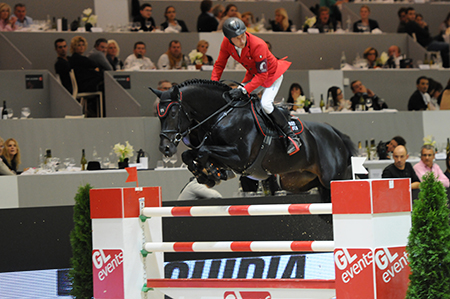
Embassy II and Hans Dieter Dreher, reserve for the German WEG team
How important is Eventing becoming as a market?
“We are very happy about the way eventing breeding is going. Our horses are very suitable and we have a lot of interest from international clients. We have sold horses to England and Ireland – we never expected that! It is a very big advantage to us that the eventing format was changed, and now the riders need a very good dressage horse, with good movement and rideability, and a good jumping horse. For me, a horse like FRH Escada is a prototype for eventing horses, she is complete. It is one of the best horses Ingrid Klimke has ridden, all she needs to do now is stay healthy…”
The Escudo line is good for eventing…
“We find there are two directions for eventing breeding. There is the Escudo bloodline – for example, Embassy – and the Contendro line, in combination with Thoroughbred, like Heraldik. With eventing horses, sometimes you have to look to find them, it is not so easy to breed them.”
See I don’t agree with you, when you look at the few people who tried to breed eventers, like Friedrich Butt, even with limited resources they were very successful…
“Okay, maybe it is better to say, there are only a few people who breed for eventing so there are not so many horses, and we need more, and sometimes find them in stables which had no intention of breeding eventers. For example, Sherlock Holmes, you would never have expected him to breed an eventer, but he bred a great eventing horse (FRH Serve Well with Andreas Dibowski)… we have to keep an eye out for eventers in all sorts of places, but I am very happy with the younger generation of eventing horses. I think the Bundeschampionate has been very successful in the last few years bringing on future eventing horses. The Hanoverians have supplied a very high proportion of the finalists in recent years, and to keep winning medals we need a lot of horses.”
With the death of Heraldik, there is no obvious leader when it comes to an eventing stallion…
“On the Thoroughbred side it is very difficult. I don’t think we have a clear candidate like Heraldik. We are very happy that we have some very good Heraldik mares, and they are interesting with the Contendro blood. I think we are missing a strong Thoroughbred stallion.”
Even with all the problems in European breeding, you are still confident of the future for the Hanoverian association?
“Oh yes, I am very satisfied with the development of the quality. We were a little bit afraid with the declining numbers that we would have a quality problem but so far it doesn’t look like that. In recent years at every level – young mares, young stallions, at the Bundeschampionate, or the Youngster Tour in Jumping, the World Championships for Young Dressage horses, or the Burgpokal – the Hanoverian position is becoming stronger, we have more and more horses at the top. We have to keep an eye on the jumping side, I think we have a good jumping horse for the amateur rider but we need more horses in the international top competition. I have doubts that this is only a breeding program, it is also to do with the education of the horses, but we will be concentrating more on supporting riders and young horses to go to the next level.”
“On the whole I am happy, despite the structural changes, the good breeders keep on going. Our selection system is also working well, but we again have to concentrate, we have to keep improving all the time…”
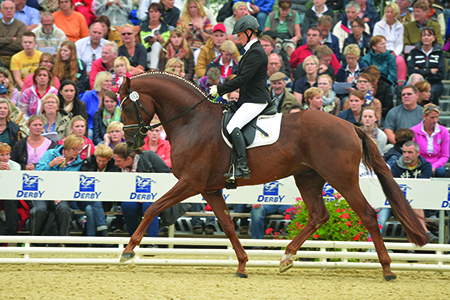
Bodyguard by Burlington at the 2013 Bundeschampionate

Great insights. Escudo’s influence will undoubtedly continue to grow.
Insightful and wise information